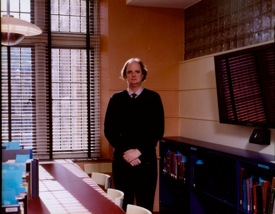Today’s post comes from Delphine Douglas, class of 2018 and Art Center Multimedia Student Assistant

On Friday, January 26, the Frances Lehman Loeb Art Center hosted a lecture and reception to celebrate the opening of the new exhibition, People are Beautiful: Prints, Photographs, and Films by Andy Warhol. Vincent Fremont delivered the opening lecture, titled “Reel to Real: Andy Warhol’s World,” in Taylor Hall 102. Fremont began working for Andy Warhol in the summer of 1969 and continued to work for The Factory for nearly 20 years, mainly as a producer for video and films. His life’s work continues to center on his experiences working with Warhol including involvement in founding the Andy Warhol Foundation for the Visual Arts and establishing the Andy Warhol Museum. He’s also currently writing a memoir about his experience working with Warhol.

Dolly Parton, 1985
Polaroid Polacolor ER print
Collection of Neuberger Museum of Art, SUNY Purchase. © The Andy Warhol Foundation for the Visual Arts, Inc. EL 02.2008.17
Fremont’s lecture was a fast-paced run-through of highlights of works on view in the new exhibition, explained as they relate to Fremont’s personal experience working with Warhol. Fremont’s description of this post-factory-era Warhol career emphasized the way personality, chance, and artistic talent collided to create the enormous force that was Warhol’s artistic output. It made sense then for Fremont to discuss the Warhol portraits in terms of personal anecdotes and stories that described the circumstances that produced each of the images.
Fremont was 19 years old when he met Warhol in the summer of 1969, three months after moving to New York. In the summer of 1972, Warhol taught Fremont to use a portable video camera while vacationing in Montauk, allowing Fremont to find his niche within the Warhol world as a video person. It was from this perspective, behind the video camera, that Fremont encountered many of the subjects in Warhol’s portraits, including many of those that appear in People are Beautiful. Fremont described filming Warhol staging portraits including Dolly Parton’s, for which he removed her jewelry, powdered her face and neck, and made her lean forward into the camera. He then recreated this staging in other polaroid portraits of women as seen in People are Beautiful.
Fremont was careful to emphasize Warhol’s artistry, pointing to his creative decisions to make all of his women subjects fit an idealized womanly type, to the point of almost obscuring their identities with heavy makeup and post-production edits to their features. This aesthetic, as seen in Warhol’s portraits of Dolly Parton as well as Emily Landau and Anne Bass, reads as ironic and playful given the celebrity-status and extreme recognizability of Warhol’s subjects.

Anne Bass, 1981
Polaroid Polacolor 2 print
Collection, Neuberger Museum of Art, SUNY Purchase.
© The Andy Warhol Foundation for the Visual Arts, Inc. EL 02.2008.08
The idea that life with Warhol was a constant social affair that served as a breeding ground for creativity came up again and again, including during the question and answer portion of the lecture. Here, Fremont offered an anecdote about Georgia O’Keeffe and Pablo Picasso happening to visit Warhol’s studio at the same time, and Fremont then being able to take video footage of the two together while Warhol photographed.




